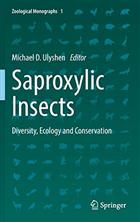Saproxylic Insects: Diversity Ecology and Conservation
- Series : Zoological Monographs
Volume: 1 - Publisher : Springer
- Illustrations : 111 illus (88 col)
Our customers have not yet submitted a review for this title - click here to be the first to write a review
Description:
Provides a global and holistic understanding of saproxylic insects, including their diversity, ecology and vulnerability to ongoing and emerging threats This volume offers extensive information on insect life in dying and dead wood. Written and reviewed by leading experts from around the world, the twenty-five chapters included here provide the most global coverage possible and specifically address less-studied taxa and topics. An overarching goal of this work is to unite literature that has become fragmented along taxonomic and geographic lines. A particular effort was made to recognize the dominant roles that social insects (e.g., termites, ants and passalid beetles) play in saproxylic assemblages in many parts of the world without overlooking the non-social members of these communities. The book is divided into four parts: · Part I “Diversity” includes chapters addressing the major orders of saproxylic insects (Coleoptera, Diptera, Hymenoptera, Hemiptera, Lepidoptera and Blattodea), broadly organized in decreasing order of estimated global saproxylic diversity. In addition to order-level treatments, some chapters in this part discuss groups of particular interest, including pollinators, hymenopteran parasitoids, ants, stag and passalid beetles, and wood-feeding termites. · Part II “Ecology” discusses insect-fungal and
insect-insect interactions, nutritional ecology, dispersal, seasonality, and vertical stratification. Part III “Conservation” focuses on the importance of primary forests for saproxylic insects, offers recommendations for conserving these organisms in managed forests, discusses the relationships between saproxylic insects and fire, and addresses the value of tree hollows and highly-decomposed wood for saproxylic insects. Utilization of non-native wood by saproxylic insects and the suitability of urban environments for these organisms.
* Incorporates information from tropical and subtropical forests
* Recognizes the key roles that social insects play in saproxylic assemblages
* Highlights some of the less commonly studied taxa
* Addresses the value of highly decomposed wood
Other titles from the series : Zoological Monographs
Click to view all titles in this series...
New World Tarantulas: Taxonomy, Biogeography and Evolutionary Biology of
Perez-Miles, F. (Ed.)
Price £149.99
The Lymnaeidae: A Handbook on Their Natural History and Parasitological
Vinarski, M.V.; Vazquez, A.A. (Eds)
Price £159.99
You may also like...
The Complete Insect: Anatomy, Physiology, Evolution, and Ecology
Grimaldi, D.A. (Ed.)
Price £21.50
(Save £8.50)
A photographic guide to Insects of southern Europe and the Mediterranean
Brock, P.D.
Price £24.50
(Save £3.00)
The Hidden World: How Insects Sustain Life on Earth Today and Will Shape Our
McGavin, G.
Price £14.99















